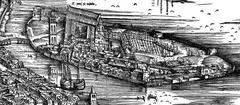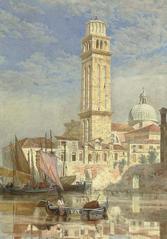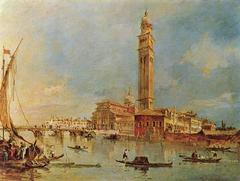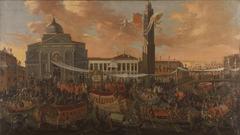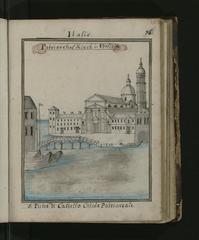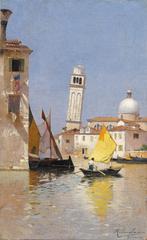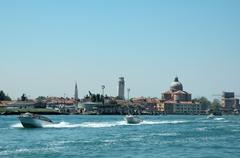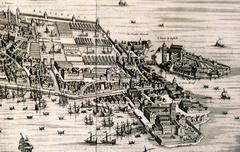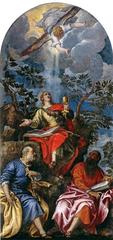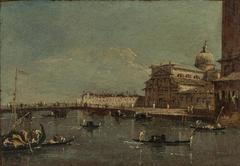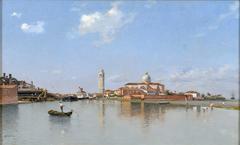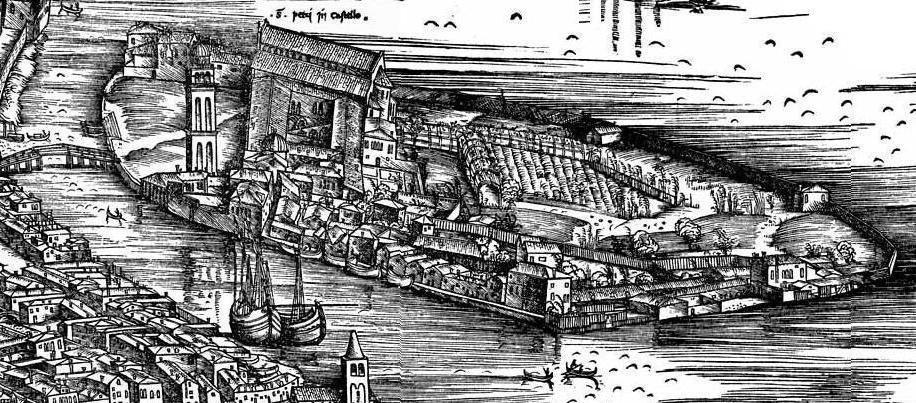
San Pietro di Castello Venice: Visiting Hours, Tickets, and Historical Guide
Date: 14/06/2025
Introduction
San Pietro di Castello is Venice’s oldest cathedral and a landmark of immense historical, architectural, and cultural value. Situated on the tranquil eastern edge of the Castello district, this remarkable basilica offers visitors a unique window into the city’s earliest Christian heritage and its Renaissance evolution. Serving as the city’s cathedral until 1807—well before St. Mark’s Basilica took precedence—San Pietro di Castello has been at the spiritual and civic heart of Venice for over a millennium (Venicexplorer.com; Italyheaven.co.uk; Venezia Unica).
This guide provides everything you need to plan your visit: up-to-date opening hours, ticketing and accessibility details, travel advice, and highlights of the church’s history, architecture, and art. Whether you are a first-time visitor or an aficionado of Venetian history, San Pietro di Castello offers a peaceful, authentic escape from the city’s busiest routes.
Table of Contents
- Early Origins and Foundational Role in Venice
- Architectural Evolution and Artistic Heritage
- Religious and Civic Significance
- The Castello District and Urban Context
- Napoleonic Transformations and Preservation
- Visiting Information: Hours, Tickets, and Accessibility
- Visitor Tips and Nearby Attractions
- Special Events and Local Traditions
- Frequently Asked Questions (FAQ)
- Summary & Recommendations
- Reliable Sources and Further Reading
Early Origins and Foundational Role in Venice
San Pietro di Castello occupies the site of one of Venice’s earliest settlements, the island historically called Isola d’Olivo, dating to the 7th century. From its beginnings as a small Christian community, the island quickly became the seat of the Bishop, and later the Patriarch, making it the spiritual heart of the nascent city (Venicexplorer.com). The church held this status as Venice’s cathedral until the early 19th century, underscoring its foundational significance.
Architectural Evolution and Artistic Heritage
Renaissance Transformation
San Pietro’s present form is a product of Renaissance vision and local craftsmanship. Andrea Palladio, the celebrated architect, designed its monumental classical façade and Latin-cross plan in the mid-16th century, executed by Francesco Smeraldi (Meeting Venice). The result is a harmonious, luminous interior, with geometric clarity and a restrained grandeur that sets it apart from Venice’s more ornate churches.
The Bell Tower
The striking campanile, built in the late 15th century by Mauro Codussi, is notable for its bright Istrian stone and slightly leaning profile (Meeting Venice). The bell tower, separate from the church, acts as a visual anchor for the district.
Interior Masterpieces
San Pietro di Castello’s interior boasts a Latin-cross layout with three aisles, a vast central dome, and side chapels. Significant artworks include:
- The high altar by Baldassare Longhena, housing the urn of Venice’s first patriarch (Meeting Venice).
- The ancient Chair of St. Peter of Antioch with Arabic motifs.
- Paintings by Tintoretto, Bellini, Veronese, Palma il Giovane, and Pietro Liberi (Venice Art Guide).
- Mosaics and a Baroque marble inlay from 17th-century restorations.
The church’s art collection is a vivid narrative of Venice’s religious and artistic evolution.
Religious and Civic Significance
As the city’s cathedral for centuries, San Pietro di Castello was the venue for the installation of bishops and patriarchs, major liturgical celebrations, and important civic gatherings. Its prominence continued until 1807, when the seat was transferred to St. Mark’s Basilica following the Napoleonic occupation (Venicexplorer.com). Despite this change, the church remains a revered place of worship and a symbol of Venetian identity.
The Castello District and Urban Context
Located on its own island at the city’s eastern edge, San Pietro di Castello is surrounded by a rare grassy campo, offering a glimpse into Venice’s pre-urban landscape (Venezia Unica). The area’s development was closely linked to the church’s presence, helping Castello emerge as the city’s largest sestiere. Close by are the Arsenale shipyards and the Giardini della Biennale, integrating spiritual, military, and cultural histories.
Napoleonic Transformations and Preservation
The Napoleonic era was a period of upheaval for San Pietro di Castello. Religious orders were suppressed, the Arsenal was closed, and the island’s cathedral status was lost (Venicexplorer.com). Nevertheless, the church survived as a community anchor. Restoration efforts in the 19th and 20th centuries preserved its architectural and artistic legacy for future generations.
Visiting Information: Hours, Tickets, and Accessibility
Opening Hours
- Monday–Saturday: 10:30 am–1:30 pm, 2:30 pm–5:00 pm
- Sunday: Closed to visitors except during mass (Catholic Shrine Basilica)
- Mass times: Tuesday, 5:00 pm; Sunday, 10:30 am
Admission
- Worship: Free during mass.
- Tourist Visits: A small fee (€3–€5) may be asked outside mass hours to support conservation (Chorus Venezia).
Getting There
- Vaporetto: ACTV lines 4.1 and 4.2 to “San Pietro di Castello” stop.
- Walking: 20–30 minutes from Piazza San Marco, through the Castello district (Venice Travel Guide).
Accessibility
- The church entrance is at ground level and accessible to wheelchairs, though some interior areas have steps or uneven floors.
- Assistance and accessible restrooms are available; contact in advance for details.
Contact
- Address: S. Pietro di Castello, 30122 Venezia VE, Italy
- Phone: +39 041 275 0462
Visitor Tips and Nearby Attractions
- Best Time to Visit: Early morning or late afternoon for tranquil atmosphere and best light.
- Dress Code: Shoulders and knees should be covered.
- Photography: Allowed without flash or tripod; always observe posted rules.
- Amenities: Limited restrooms; benches in gardens and cloisters.
- Dining: Local cafés and trattorias nearby; picnicking is possible in church gardens.
- Souvenirs: Occasionally, Harmonia Mundi wine from the church vineyard is available (Lions in the Piazza).
Nearby Attractions:
- Arsenale: Historic shipyards central to Venice’s naval power.
- Museo Storico Navale: Venice’s Naval History Museum.
- Giardini della Biennale: Gardens hosting the famous art biennale (Venice Insider Guide).
Special Events and Local Traditions
Feast of San Pietro di Castello
- When: June 29, honoring Saints Peter and Paul.
- Events: Solemn mass, concerts, community events, dances, and literary gatherings (Images of Venice).
Frequently Asked Questions (FAQ)
Q: Are there entry fees for visiting San Pietro di Castello?
A: Entry is free during mass. Outside mass times, a small fee (€3–€5) may be requested to support preservation.
Q: What are the visiting hours?
A: Monday to Saturday, 10:30 am–1:30 pm and 2:30 pm–5:00 pm. Closed to visitors Sundays except during mass.
Q: Is the basilica wheelchair accessible?
A: Yes, though some interior areas may have steps or uneven floors.
Q: Can I take photographs inside the church?
A: Discreet photography (no flash or tripod) is generally permitted.
Q: Are there special events?
A: Yes, especially the June 29 Feast of San Pietro di Castello.
Summary & Recommendations
San Pietro di Castello is a cornerstone of Venetian history, blending early Christian origins, Renaissance artistry, and a living tradition of worship and community. Its Palladian façade, Codussi’s bell tower, and interior masterpieces by Venetian artists provide a rich cultural experience away from Venice’s more crowded attractions (Meeting Venice; Venice Art Guide).
Visitors are encouraged to check current hours and ticket info, consider guided tours for deeper understanding, and plan visits around special events. Pair your trip with stops at nearby sites like the Arsenale and Giardini della Biennale for a full experience of the Castello district (Chorus Venezia). Enhance your exploration with the Audiala app, offering audio guides and interactive maps (Audiala).
Reliable sources, official websites, and further reading
- Venicexplorer.com
- Meeting Venice
- Venice Heritage Portal
- Catholic Shrine Basilica
- Chorus Venezia
- Images of Venice
- Italy Heaven
- Venice Art Guide
- Audiala
